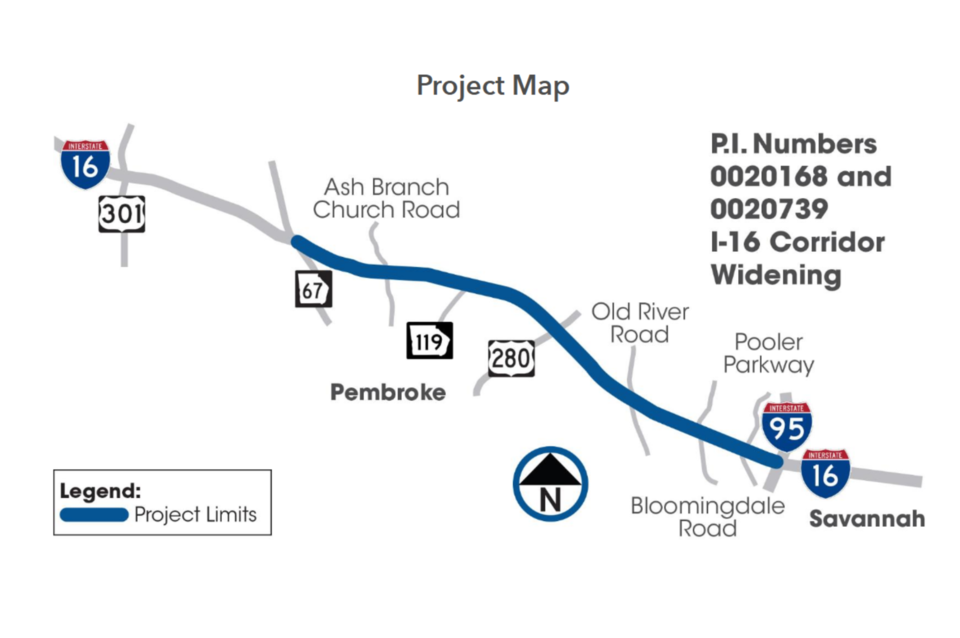The Georgia Department of Transportation's P3 Division (GDOT) held a public hearing in Statesboro on Wednesday, June 11, 2025, to gather feedback from the community on a proposed 32.5-mile widening of Interstate 16 between Interstate 95 and State Route 67, as well as the widening of 20 bridges in 10 locations.
Informational boards were set up around the room, along with a designated area for the public to submit written feedback.
This project will widen I-16 from two to three lanes in both eastbound and westbound directions across Bulloch, Bryan, Effingham and Chatham counties. It aims to improve substandard pavement conditions and accommodate increasing traffic volumes, ultimately enhancing mobility and the overall level of service throughout the corridor.

What are the current conditions of I-16?
I-16 currently includes four travel lanes in each direction west of I-95, with a median that varies between 64 and 480 feet in width. The corridor features 20 mainline bridges at 10 locations as well as a right-of-way ranging from approximately 250 to 1,800 feet. Pavement conditions are substandard and crash rates in some areas either meet or exceed Georgia's average.
This interstate also serves as a major connector for several developments, warehouses, manufacturing facilities and the Port of Savannah.
Why is this project needed?
The proposed widening of I-16 comes in response to mounting congestion, deteriorating infrastructure and the increasing importance of the corridor for freight and passenger travel. Traffic along the stretch from I-95 to SR 67 is expected to increase significantly in the coming decades, driven by the rapid growth of manufacturing, warehousing, and distribution facilities near the interstate.
Currently, the average annual daily traffic volumes range from 31,000 to 50,000 vehicles per day (vpd), with an expected increase between 52,000 to 99,000 vpd under no build conditions by 2050.
The volume-to-capacity (V/C) ratio measures how well a road handles traffic, with anything below 0.85 indicating smooth flow and anything at or above 1.0 signaling likely delays. Without the project, nearly all segments of the corridor are expected to exceed a V/C ratio of 1.0, ranging from anywhere between 1.09 to 1.61.
In addition to the anticipated increase in traffic, the current pavement conditions are deteriorating and often require frequent slab replacements.
Without this project, pavement conditions will continue to decline, leading to impaired travel, reduced traffic efficiency due to overcapacity, and an increase in both crash rates and travel times.
What are the goals and benefits of this expansion?
GDOT P3 Division aims to improve the regional reliability of both passenger and freight movements, accommodate existing and future traffic generated by regional growth and planned area developments, improve pavement conditions of the corridor and limit the impact to environmentally sensitive areas where feasible.
The benefits of this project include improved safety, reduced crash potential, greater capacity for passenger vehicles and trucks, better access to the interstate system for major developments, warehouses, and manufacturing facilities, and the replacement of aging pavement and bridges.
Where is this project currently at and what are the next steps?
This project is currently in the concept phase, which aims to both define the existing issue in need of being resolved and provide a proposed solution that will meet the community's needs.
Public feedback from the meeting will be reviewed and may lead to revisions of the proposed plan or the selection of the no-build alternative. Once the Concept Report is approved, the project alignment will be refined, and any major changes will trigger additional public outreach. GDOT anticipates the conclusion of the environmental process in May 2026, followed by project development and developer selection later that year.
Construction is expected to begin in 2027 and last approximately three to four years. Most work will be done at night to minimize traffic disruptions, but some daytime lane closures will be necessary.
Online commentary is encouraged and will be welcomed up until Thursday, June 26, 2025. Either of the following methods may be used to provide feedback:
- Click here for an online commentary form.
- Mail in a comment card to Eric Duff, Georgia Department of Transportation, 600 West Peachtree Street NW, 16th Floor, Atlanta, Georgia, 30308.
For more information about the project and contact details, click here.




